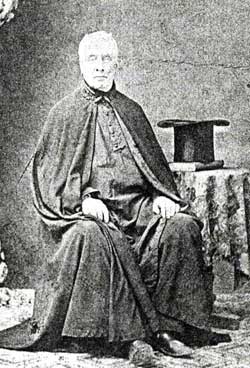
| Fr. Anthony Fahy O.P.[1] | ||
|
But true hearts will treasure the name of
him, [2]
Apostle prized from
Patrick’s land
He came top bear their
faith afield
Nor power nor wealth
until his death
Down to the last grim
sacrifice
Our pride it is he took his stand
His heart was large his
means were small
He gave us name and
nation here Conor Mac Nessa [5]
|
|
|
In any field of endeavour few reach the greatest heights of achievement. Fewer still transcend even that fame to touch the renown possessed by Canon Anthony Fahy O.P. Between 1850 and the 1870’s everybody in Buenos Aires knew who he was. He had ease of access to bishops, presidents, politicians, newspaper proprietors and editors, bankers, ship owners, merchants and farmers. And if he had the entreé to the great of society, then Irish immigrants and the many not so greats of society had access to their chaplain. He was famous, but totally unaffected by fame. Both catholic and non-catholic alike respected his integrity, honesty and total lack of humbug. Direct of speech, almost gruff when he enquired of all who came to see him “who are you and what do you want”, he was not much given to idle chit chat or gossip. He was a man of God, ever practical and always assiduous in caring for his far flung flock. And they in turn loved and revered the humble friar who was everybody’s priest – Irish and Argentine alike. Today he is still remembered in Argentina, two hundred years after his birth on 11 January 1805, by the Instituto Fahy, Moreno, which bears his name and a street in the Federal Capital named in his honour. His extrodinary work and shining priestly zeal had not gone unnoticed and in recognition of his long service to the Irish Community he was named an Honorary Canon of the Cathedral of Buenos Aires by President Bartolomé Mitre. A totally unique honour for a foreigner and Dominican friar. |
||
|
There are many myths and legends concerning Anthony Fahy and as a Hollywood scriptwriter wrote “when the truth becomes legend print the legend.” But what are the facts about Fahy’s death as this is a fascinating example of how historical myth is fabricated. Anthony Fahy died of heart attack on 20 February 1871, and the newspapers reported that he died of yellow fever owing to his attending a sick Italian woman. This was widely reported as fact and most people accepted that he died of yellow fever. But the death certificate signed by two doctors, unequivocally states that “...he died from heart disease." [7] This writer had often heard and read that Anthony Fahy always wore a top hat, but never saw any evidence until finding one such photograph. [8] By Edward Walsh*
[1] This poem, published in a six page A5 format booklet entitled A Tribute to Father Fahy was printed by Talleres Peuser and contains a 3¼” x 4½” photograph of Anthony Fahy O.P. dressed in black, holding a small open book in his right hand which is positioned just above his left hand. St Brigid’s. Gaona, 1482 Flores, 31 August 1919. [2] This four line verse is printed on the fronts-piece below the booklet title. [3] Pastor Obligado (1818-1870) b.Buenos Aires, the son of Manuel Alejandro Obligado. A lawyer and first constitutional governor of Buenos Aires, he belonged to a prominent Porteño family and played an important role during the separation of Buenos Aires from the other provinces. [4] Juan Manuel de Rosas (1783-1877) military and political leader of Argentina. Governor of Buenos Aires (1835-52) with dictatorial powers. His spies and secret police intimidated all opposition so that by 1840 few dared to oppose him. Overthrown at the battle of Caseros by Justo José de Urquiza, Rosas fled to England where he ended his days farming near Southampton (see John Lynch, Argentine Dictator Juan Manuel Rosas 1829-52, Clarendon Press, Oxford, 1981). [5] Conor Mac Neassa (also spelt Mac Neasa) was one of a number of pen names used by Patrick MacManus. [6] Patrick McManus (1864-1929) see Helen Meehan The McManus Brothers, Patrick : (1864-1929), Seamus : 1868-1960 in The Donegal Annual, Journal of the Donegal Historical Society, No.46, 1994, pp.5-18; Patrick McManus (1864-1929) in Sinsear, No.8, 1995 pp.147-155; The McManus Family of Rossylongan in Donegal Association Yearbook, Dublin, 1998, pp.52-53. [7] ThomasMurray, TheStory Of The Irish In Argentina, P.J.Kennedy & Sons, New York, 1919, Ch.XX, p.344. [8] I am indebted to Pauline Ingram O.P. and Marjorie Buttner O.P. for giving me access to the Cloran/Fahy Papers at the Sinsinawa Dominican Archives, Sinisinawa, Wisconsin, USA. * Edward Walsh is an independent scholar who lives in London. He wrote An Irish Catholic Association Pilgrimage to Lujan, Province of Buenos Aires (1918?) in: 'Collectanea Hibernica, Sources For Irish History' Vol. 42 (Killiney, Co. Dublin, 2000), pp. 242-244, and The Irish in the Argentine Republic: John Cullen's 1888 Report, in: 'Collectanea Hibernica, Sources For Irish History' Vol. 43 (Killiney, Co. Dublin, 2001), pp. 239-246.
|
||
| © Edward Walsh, Irish Argentine Historical Society | ||
| Last Update: January 2005 | ||
| Please contact us if you have a question or wish to suggest changes |
Copyright © The Irish Argentine Historical Society. 2005 |

